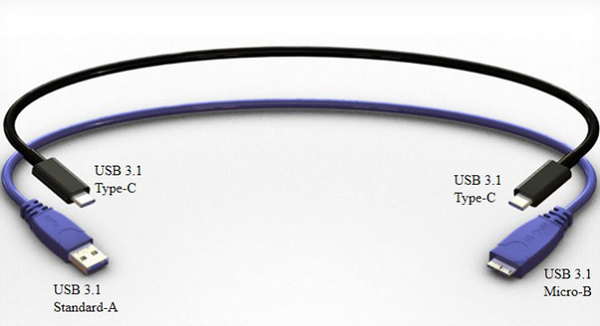One USB To Rule Them All: USB Type-C Connector Specification Finalized
The USB Type-C specification was finalized on Wednesday and now heads off to the USB Implementers Forum (USB-IF). This specification, first announced last December (pdf), describes a new type of connector that is similar to a USB 2.0 Micro-B port in size, but it is shaped in such a way that -- similar to Apple's Lightning cable -- it doesn't matter which side is up when plugged in.
The USB 3.0 Promoter Group indicated that the new specification will be great for tablets and laptops and ideal for smartphones with slim form factors. This solution supports 10 Gbps (USB 3.1) speeds and provides a USB power delivery up to 100 watts thanks to the USB Power Delivery specification.
The mechanical specifications show that the receptacle opening measures roughly 8.4 x 2.6 mm. That means a USB Type-C cable will not plug into a USB port installed in today's devices. But that's not a huge deal, as there will be adapters and "new-to-existing" cables fitting all USB sizes when Type-C cables begin to hit the market.
The group provides an example of how the new Type-C could be used, describing a dock that has one Type-C connector for powering a connected notebook. There's also a hub within this dock for connecting several screens that stream video with additional bandwidth left over for other things like peripherals and more.
"The release of the USB Type-C specification is the final piece in developing a single-cable solution. The combination of SuperSpeed USB 10 Gbps and USB Power Delivery up to 100W with the slim, user-friendly USB Type-C connector provides endless possibilities," the press release said.
A knee-jerk reaction to this news may be skepticism over whether we really need another USB cable, but that's not what's happening here -- this spec is designed to replace them all. Of course, the rollout in devices will be slow, hence the special adapters and cords for "legacy" USB devices.
Follow Kevin Parrish @exfileme. Follow us @tomshardware, on Facebook and on Google+.
Get Tom's Hardware's best news and in-depth reviews, straight to your inbox.

Kevin Parrish has over a decade of experience as a writer, editor, and product tester. His work focused on computer hardware, networking equipment, smartphones, tablets, gaming consoles, and other internet-connected devices. His work has appeared in Tom's Hardware, Tom's Guide, Maximum PC, Digital Trends, Android Authority, How-To Geek, Lifewire, and others.
-
pbrigido I'm most excited about the ability to plug it in, in any orientation. If there are 2 ways to plug in a USB cable, I always find the opposite one first.Reply -
hoofhearted "this spec is designed to replace them all"Reply
Wasn't this the intent of USB when it was first rolled out? -
dstarr3 ReplyI'm most excited about the ability to plug it in, in any orientation. If there are 2 ways to plug in a USB cable, I always find the opposite one first.
Usually takes me three tries before I get it right. Don't know how, but that's how it goes for me. -
boytitan2 I don't want this at all. Micro b breaks enough. This type C is even smaller than B no thanks.Reply -
SirKnobsworth Reply"this spec is designed to replace them all"
Wasn't this the intent of USB when it was first rolled out?
Yes, but they might actually succeed this time. USB Type C is now small enough for mobile devices and they've eliminated the need for separate host/device connectors. It's also got a lot of room for expansion - there are 6 unused pins beyond the current USB signaling specs. The USB signaling pins are even reconfigurable in specific use cases. This could allow things like running PCIe or display signals over the same cable without having to go through Thunderbolt, or simply speeding up USB at some point in the future by adding another superspeed link. -
nthreem Reply13956095 said:100 Watts? Won't the cable get really really hot?
Heat generation through cabling and devices is mainly due to resistance. Resistance of wiring will decrease proportionally with increase of cable thickness. Higher power demand will mean additional current through the wire.
You're right to think that if they increased power delivery to 100W without beefing up the cable, it'd get pretty hot. Imagine having a USB cable 10 times the thickness of your existing cable designed for 10W @ 2Amps. That'd be ridiculous.
Fortunately, the new USB 3.1 spec increases operating voltage to 20V when delivering power up to 100W. There can still be 5V powered devices, but you'd be limited to only 10W, which most tablets, chargers, USB cables, are designed to handle already.
So you're talking about an increase to 5A, which is much more manageable from a cabling standpoint than 20A if they had maintained 5V operating voltage. -
hannibal The ability to plug this without checking orientation is good, but the durability is something that may be not so stellar. I almost hope that there would be USB C and USB mini connectors...Reply
-
Osmin I would have been more excited if it included an optional fiber cable down the center to be able to pass Thunderbolt 3+ speeds in the future. This would eliminate the need for other special cables and even replace the display port cables. One cable to truly rule them all. I am looking forward to ditch all the different USB cables for just one standard.Reply -
none12345 While a reversable connector is good....its still dumb. They should have taken the opportunity to do a surface contact connector with a magenetic attachment.Reply
While ive never broken a usb connector(standard, micro, or otherwise), the first thing i think of when i look at this thing is its going to break off.
They should have taken the opportunity to just solve the issue for good. But guess there will be a type d cable at some point to correct that mistake.
